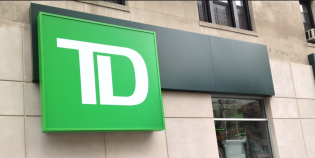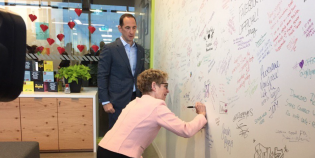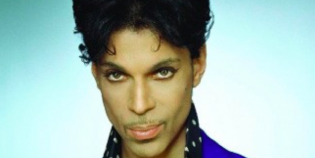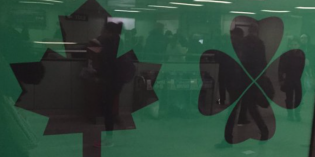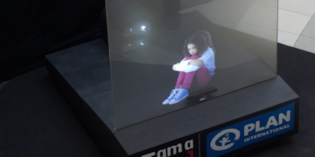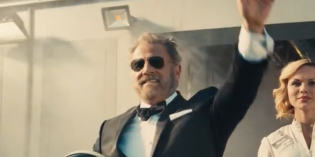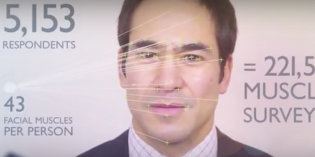Think about bank advertising. Think about all the campaigns currently in market for financial products, services and brands. Now try to match each one with a major Canadian bank.
Not easy, is it? It’s all smiling faces delivering aspirational messaging. And a lot of the colour blue.
Now ask yourself “Would it have taken me so long if I had to match fast food or supermarket campaigns?” Probably not.
This “sea of sameness” is what Jim Little saw when he took over as chief brand and communications officer at RBC in March 2007. Arriving from Bell Canada, where he oversaw the launch of the “Beavers” campaign, Little was eager to make a splash. He partnered with the bank’s agency of record BBDO to create “Create”—a campaign that tries to break the surface in the sea of sameness and help customers find their way to the local RBC branch.
“We clearly wanted a change,” he says. “I remember saying, we need the people at our agency to want to work on this business because it’s the most creative thing the agency’s doing. At that stage, that wasn’t the case.”
Little and Ignazi are sitting at opposite ends of a meeting table in Little’s office discussing the challenges of making compelling bank ads. “We really wanted to make RBC look like our [size] was a benefit to the client, not an obstacle,” Little says.
The company had mixed results with previous campaigns, running the “First for you” tag line for four years prior to Little’s arrival. “They couldn’t identify one bank from the other,” he says of consumer response to bank advertising. “There was no messaging or approach.”
After getting their marching orders from Little, BBDO hunkered down for three days and “plastered the walls” with ideas, according to Ignazi. They were trying to find something to put the bank on the map. By the time they brought Little back in, they had come up with three recommendations.
“One was focused on personal stories,” Ignazi says. “It was about individuals and how we helped them achieve their goals. The other was more focused on the bank again, its expertise and what it could bring to consumers.”
In the end, however, the two companies settled on an approach that looked at “everything that was great about the bank and what the customer could do with it. It was more consumer-focused.”
The creative would be highly stylized and artistically bold. Create’s hallmark is its use of 3-D animation from some of the world’s top studios, such as London, U.K.-based Mr. Hyde and Paris-based Nexus.
The first TV spot, called “Mr. Long Legs,” for the Avion Visa credit card, broke during the Summer Olympics. It featured a man with surreally long legs traveling around the world by striding across cities, oceans and continents. The gentle colour palette and folksy soundtrack are unique in the sector, although the aspirational message that ends the spot is in step with competitors: “Create the freedom to travel.”
Next came “Mr. Muffin,” another animated character who turns his small outdoor muffin stand into a giant restaurant, theme park and franchise with financial advice from RBC.
The ads also marked the debut of Arbie, a blue-suited, bowler hat-wearing character created by BBDO’s Proximity interactive division to represent RBC’s main offering: advice. He puts a face on the bank’s globe-spanning, 75,000-employee operation, and he has begun appearing in television and print advertisements for mortgages, mobile banking and Olympic sponsorships. Even newer ads that aren’t animated feature Arbie at the end. Little says the mascot will be prominently featured in an Olympic torch relay ad set to debut in late December.
That worked fine during the Olympics when spirits were as high as the dollar, but as the economy turned sour in October people began viewing banks differently. More testing was required to see if the mascot was still the way to go. Luckily for Arbie, Ipsos research proved he was.
“The testing showed that the more you see Arbie, the more you like him and understand his role,” Little says. “So you’ll be seeing Arbie in the future.”
Research on specific ad executions also convinced the team they were on the right track. New Avion Visa accounts went up by 27% during the “Mr. Long Legs” campaign over the 2007 campaign. By the end of the bank’s fourth fiscal quarter, Mr. Muffin had tripled brand link and recall metrics over First for you. The brand’s overall unaided awareness went up 30% during the fourth quarter as well. Little and Ignazi had made their splash.
They did it by changing the way the companies had traditionally worked together. When Little arrived he decided to keep BBDO without a review. “The promise of a great relationship with BBDO was there going in, so I decided that if I could avoid changing agencies, I would,” says Little. While Ignazi says he’s constantly defending the account with good creative and management, he no doubt breathed easier when Little gave him the good news. After all, RBC is the agency’s single largest client. The Nielsen Company reported its 2007 media spend as more than $42 million.
Even though there was no review, there were significant changes in how the work was done. Vince Aragona, director of advertising and in-branch marketing at RBC, moved over to BBDO in January to lead the RBC-dedicated account team. Aragona had worked agency-side before and had considerable experience at several banks before coming to RBC. He spearheaded the push to bring the client and agency teams closer together.
“We set about rebuilding the agency team as we rebuilt the internal team,” Little says. “It wasn’t a separate thing. Now there’s no line between us. Peter’s in the office every other day… It’s a partnership and almost a family.”
Ignazi and creative partner Carlos Moreno took over creative oversight and succeeded in creating the internal love for the account that Little sought. Creatives now come asking to work on the account, but as Aragona pointed out, “We’re in the unlucky position of saying ‘We’re full up.’ ”
Create is now going global, as RBC develops its brand in foreign markets. Each region will get its own flavour of the campaign, because while it has the authority of a gigantic 144-year-old institution in Canada, it has a lot of ground to cover beyond its borders. So once he’s done bringing the Olympic torch to British Columbia, Arbie may start appearing in the Caribbean, the U.K. and other countries where he’s testing well.
Having dived into a sea of sameness, Arbie’s off to hunt bigger fish in international waters.



